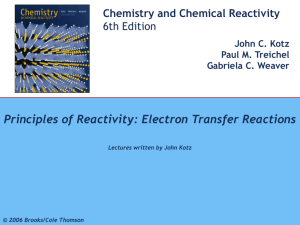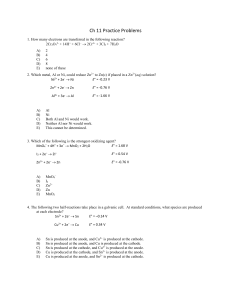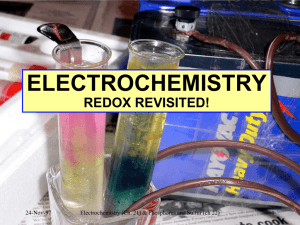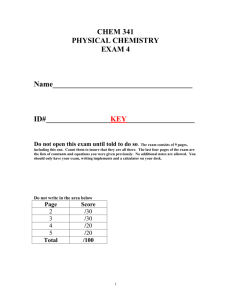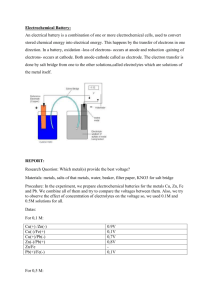Oxidation_reduction. Cells. Balancing redox reaction
advertisement
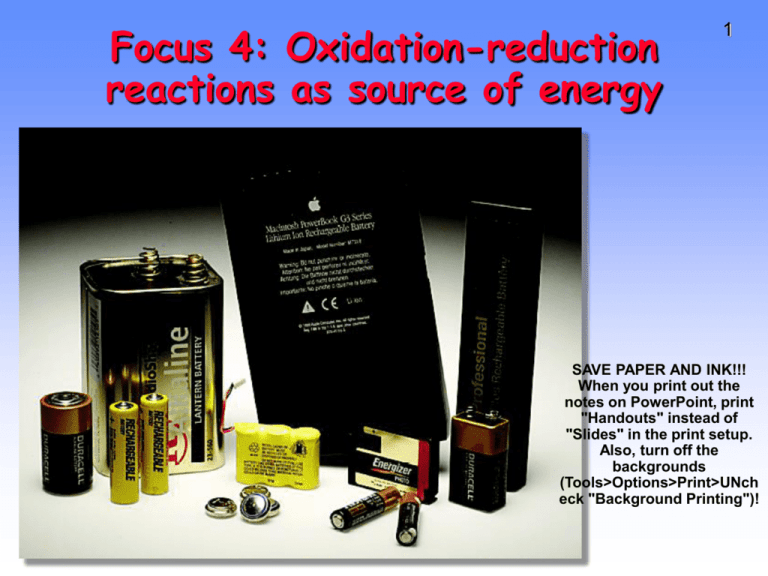
Focus 4: Oxidation-reduction reactions as source of energy 1 SAVE PAPER AND INK!!! When you print out the notes on PowerPoint, print "Handouts" instead of "Slides" in the print setup. Also, turn off the backgrounds (Tools>Options>Print>UNch eck "Background Printing")! 2 Oxidation-reduction Reactions • Oxidation-reduction or redox reactions are reactions where electrons are transferred . • This results in the generation of an electric current (electricity) • Therefore, this field of chemistry is often called ELECTROCHEMISTRY. Terminology for Redox Reactions 3 • OXIDATION—loss of electron(s) by a species; increase in oxidation number; increase in oxygen. • REDUCTION—gain of electron(s); decrease in oxidation number; decrease in oxygen; increase in hydrogen. • OXIDIZING AGENT or oxidant—the substance that accepts the electron or the species is reduced. • REDUCING AGENT or reductant—the substance that donates the electron or the species that is oxidized. 4 Activity Series of Metals • Recall from Prelim Chem the activity series of metals where metals can be arranged from the most active to the least active 5 OXIDATION-REDUCTION REACTIONS in metal displacement reactions What happens when a copper wire is placed in a is placed in a solution of silver nitrate? Observations: What is the explanation? Equation: Cu(s) + 2 Ag+(aq) ---> Cu2+(aq) + 2 Ag(s) 6 What is happening in this redox? • Which is the oxidation reaction? • Which is the reduction reaction? 7 Worksheet on Redox • See sheet: “HSC Chemistry- Revision sheet on oxidation and reduction” • Textbook, pg 45 Exercise Q1 - 8 • Worksheet 10 – Oxidation and reduction You can’t have one… without the other! • Reduction (gaining electrons) can’t happen without an oxidation to provide the electrons. • You can’t have 2 oxidations or 2 reductions in the same equation. Reduction has to occur at the cost of oxidation LEO the lion says GER! GER! 8 9 Another way to remember • OIL RIG Where do other redox reactions occur? • Batteries • Corrosion • Industrial production of chemicals such as Cl2, NaOH, F2 and Al • Biological redox reactions The heme group 10 11 Electrochemical Cells • A device that uses a chemical reaction (redox) to create an electric current. • Product favored reaction ---> voltaic or galvanic cell ----> electric current • Reactant favored reaction ---> electrolytic cell These are voltaic cells (It uses an electric current A battery is actually several cells is used to create a joined together in a common chemical change) outer casing. Eg a car battery. Basic Concepts of Electrochemical Cells Anode Cathode 12 What are the components of a galvanic cell? 13 • Electrode – the metallic conducting plates of a galvanic cell • Anode – This is negative in a galvanic cell. It is the metallic plate where ox….. • Cathode – This is positive. It is the metallic plate where red…… • Electrolyte – a substance that releases ions when in solution (or when melted it carries a current – meaning in a electrolytic cell) • Half-cell – refers to either the oxidation or reduction half of an electrochemical cell • Salt bridge-a bridge containing an electrolyte that joins the half-cells so as to allow a movement of ions to maintain a balance of charges What happens in a galvanic cell or voltaic cell? . http://www.mhhe.com/physsci/chemistry/essentialchemistry/flash/galvan5.swf 14 15 Zn --> Zn2+ + 2eOxidation Anode Negative Cu2+ + 2e- --> Cu <-Anions Cations-> Reduction Cathode Positive RED CAT •Electrons travel thru external wire and the voltmeter moves from left to right. •Salt bridge allows anions and cations to move between electrode compartments so as to ensure the whole solution is neutral. 16 Terms Used for Voltaic Cells 17 Calculating Cell Voltage • Balanced half-reactions can be added together to get overall, balanced equation. Zn(s) ---> Zn2+(aq) + 2eCu2+(aq) + 2e- ---> Cu(s) -------------------------------------------Cu2+(aq) + Zn(s) ---> Zn2+(aq) + Cu(s) If we know Eo for each half-reaction, we could get Eo for net reaction. TABLE OF STANDARD REDUCTION POTENTIALS oxidizing ability of ion Eo (V) Cu2+ + 2e- Cu +0.34 2 H+ + 2e- H2 0.00 Zn2+ + 2e- Zn -0.76 To determine an oxidation from a reduction table, just take the opposite sign of the reduction! reducing ability of element 18 Zn|Cu Electrochemical Cell 19 + Anode, negative, source of electrons Cathode, positive, sink for electrons Zn(s) ---> Zn2+(aq) + 2eEo = +0.76 V Cu2+(aq) + 2e- ---> Cu(s) Eo = +0.34 V --------------------------------------------------------------Cu2+(aq) + Zn(s) ---> Zn2+(aq) + Cu(s) Eo = +1.10 V 20 This is found on your HSC data sheet. (Also see your wiki) Measuring standard electrode potentials All electrode potentials are measured relative to the standard hydrogen electrode. The standard electrode potential, E° of an electrode is the potential of that electrode in its standard state relative to the standard hydrogen electrode. 21 22 CELL POTENTIAL, E • For Zn/Cu cell, potential is +1.10 V at 25 ˚C and when [Zn2+] and [Cu2+] = 1.0 M. • This is the STANDARD CELL POTENTIAL, Eo • —a quantitative measure of the tendency of reactants to proceed to products when all are in their standard states at 25 ˚C and 100 kPa pressure and electrolyte conc of 1.0 mol/L and compared to the standard hydrogen electrode. Eo for a Voltaic Cell Cd --> Cd2+ + 2eor Cd2+ + 2e- --> Cd Fe --> Fe2+ + 2eor Fe2+ + 2e- --> Fe All ingredients are present. Which way does reaction proceed? 23 Eo for a Voltaic Cell From the table, you see • Fe is a better reducing agent than Cd • Cd2+ is a better oxidizing agent than Fe2+ 24 More About Calculating Cell Voltage 25 Assume I- ion can reduce water. 2 H2O + 2e- ---> H2 + 2 OHCathode 2 I- ---> I2 + 2eAnode ------------------------------------------------2 I- + 2 H2O --> I2 + 2 OH- + H2 Assuming reaction occurs as written, E˚ = E˚cat+ E˚an= (-0.828 V) - (- +0.535 V) = -1.363 V Minus E˚ means rxn. occurs in opposite direction (the connection is backwards or you are recharging the battery) Charging a Battery When you charge a battery, you are forcing the electrons backwards (from the + to the -). To do this, you will need a higher voltage backwards than forwards. This is why the ammeter in your car often goes slightly higher while your battery is charging, and then returns to normal. In your car, the battery charger is called an alternator. If you have a dead battery, it could be the battery needs to be replaced OR the alternator is not charging the battery properly. 26 Dry Cell Battery Anode (-) Zn ---> Zn2+ + 2eCathode (+) 2 NH4+ + 2e- ---> 2 NH3 + H2 27 Alkaline Battery Nearly same reactions as in common dry cell, but under basic conditions. Anode (-): Zn + 2 OH- ---> ZnO + H2O + 2eCathode (+): 2 MnO2 + H2O + 2e- ---> Mn2O3 + 2 OH- 28 29 Mercury Battery Anode: Zn is reducing agent under basic conditions Cathode: HgO + H2O + 2e- ---> Hg + 2 OH- 30 Lead Storage Battery Anode (-) Eo = +0.36 V Pb + HSO4- ---> PbSO4 + H+ + 2eCathode (+) Eo = +1.68 V PbO2 + HSO4- + 3 H+ + 2e---> PbSO4 + 2 H2O 31 Ni-Cad Battery Anode (-) Cd + 2 OH- ---> Cd(OH)2 + 2eCathode (+) NiO(OH) + H2O + e- ---> Ni(OH)2 + OH- H2 as a Fuel Cars can use electricity generated by H2/O2 fuel cells. H2 carried in tanks or generated from hydrocarbons 32 33 Balancing Equations for Redox Reactions Some redox reactions have equations that must be balanced by special techniques. MnO4- + 5 Fe2+ + 8 H+ ---> Mn2+ + 5 Fe3+ + 4 H2O Mn = +7 Fe = +2 Mn = +2 Fe = +3 34 Balancing Equations Consider the reduction of Ag+ ions with copper metal. Cu + Ag+ --give--> Cu2+ + Ag Balancing Equations Step 1: Divide the reaction into half-reactions, one for oxidation and the other for reduction. Ox Cu ---> Cu2+ Red Ag+ ---> Ag Step 2: Balance each element for mass. Already done in this case. Step 3: Balance each half-reaction for charge by adding electrons. Ox Cu ---> Cu2+ + 2eRed Ag+ + e- ---> Ag 35 Balancing Equations Step 4: Multiply each half-reaction by a factor so that the reducing agent supplies as many electrons as the oxidizing agent requires. Reducing agent Cu ---> Cu2+ + 2eOxidizing agent 2 Ag+ + 2 e- ---> 2 Ag Step 5: Add half-reactions to give the overall equation. Cu + 2 Ag+ ---> Cu2+ + 2Ag The equation is now balanced for both charge and mass. 36 Balancing Equations Balance the following in acid solution— VO2+ + Zn ---> VO2+ + Zn2+ Step 1: Write the half-reactions Ox Zn ---> Zn2+ Red VO2+ ---> VO2+ Step 2: Balance each half-reaction for mass. Ox Zn ---> Zn2+ Red 2 H+ + VO2+ ---> VO2+ + H2O Add H2O on O-deficient side and add H+ on other side for H-balance. 37 Balancing Equations Step 3: Balance half-reactions for charge. Ox Zn ---> Zn2+ + 2eRed e- + 2 H+ + VO2+ ---> VO2+ + H2O Step 4: Multiply by an appropriate factor. Ox Zn ---> Zn2+ + 2eRed 2e- + 4 H+ + 2 VO2+ ---> 2 VO2+ + 2 H2O Step 5: Add balanced half-reactions Zn + 4 H+ + 2 VO2+ ---> Zn2+ + 2 VO2+ + 2 H2O 38 39 Tips on Balancing Equations • Never add O2, O atoms, or O2- to balance oxygen. • Never add H2 or H atoms to balance hydrogen. • Be sure to write the correct charges on all the ions. • Check your work at the end to make sure mass and charge are balanced. • PRACTICE! 40 Exercises • Textbook, pg 71 Q23 - 28

